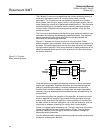
Reference Manual
00809-0100-4697, Rev EA
October 2011
Rosemount 848T
C-6
Backup LAS
A LM device is one that has the ability to control the communications on the
bus. The LAS is the LM capable device that is currently in control of the bus.
While there can be many LM devices acting as backups, there can only be
one LAS. The LAS is typically a host system but for stand-alone applications,
a device may be providing the role of primary LAS.
Addressing To setup, configure, and communicate with other devices on a segment, a
device must be assigned a permanent address. Unless requested otherwise,
it is assigned a temporary address when shipped from the factory.
F
OUNDATION fieldbus uses addresses between 0 and 255. Addresses 0
through 15 are reserved for group addressing and for use by the data link
layer.
If there are two or more devices on a segment with the same address, the first
device to start up will use the assigned address. Each of the other devices will
be given one of the four temporary addresses. If a temporary address is not
available, the device will be unavailable until a temporary address is available.
Use the host system documentation to commission a device and assign a
permanent address.
Scheduled Transfers Information is transferred between devices over the FOUNDATION fieldbus
using three different types of reporting.
Publisher/Subscriber
This type of reporting is used to transfer critical process loop data, such as the
process variable. The data producers (publishers) post the data in a buffer
that is transmitted to the subscriber, when the publisher receives the Compel
Data (CD). The buffer contains only one copy of the data. New data
completely overwrites previous data. Updates to published data are
transferred simultaneously to all subscribers in a single broadcast. Transfers
of this type can be scheduled on a precisely periodic basis.
Report Distribution
This type of reporting is used to broadcast and multicast event and trend
reports. The destination address may be predefined so that all reports are
sent to the same address, or it may be provided separately with each report.
Transfers of this type are queued. They are delivered to the receivers in the
order transmitted, although there may be gaps due to corrupted transfers.
These transfers are unscheduled and occur between scheduled transfers at a
given priority.
Client/Server
This type of reporting is used for request/response exchanges between pairs
of devices. Like Report Distribution reporting, the transfers are queued,
unscheduled, and prioritized. Queued means the messages are sent and
received in the order submitted for transmission, according to their priority,
without overwriting previous messages. However, unlike Report Distribution,
these transfers are flow controlled and employ a retransmission procedure to
recover from corrupted transfers.


















